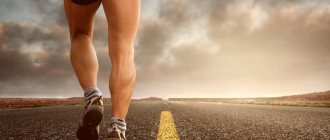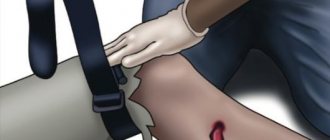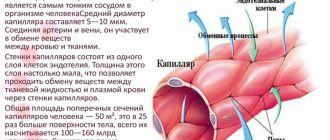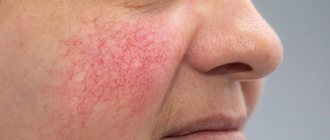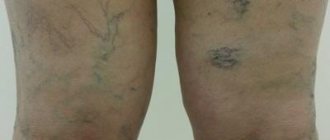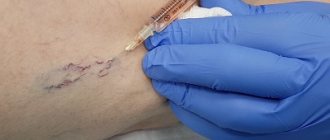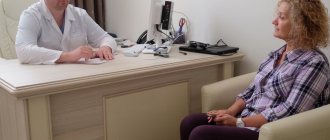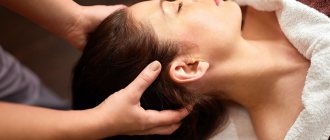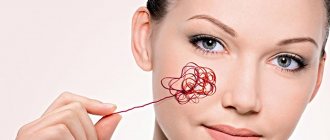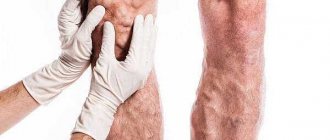The price to pay for walking upright: how varicose veins work
Varicose veins are the expansion of varicose veins.
The veins in the legs are needed for the outflow of blood: blood flows through the arteries to the leg, through the veins - from the legs to the heart. My legs are always down, the blood has to flow against the force of gravity - up, it’s hard. The legs have the most unfavorable blood flow in the entire body.
“Genetically, a person is not yet fully adapted to walking upright, so there are weak points in the body,” explains Dmitry Averyanov. Every third woman and every fifth man initially has weak spots in the veins of the legs. During life, the vein in these places expands due to stress: for some from pregnancy, for others from lifting heavy objects or being overweight. There can be many reasons, but the root cause is weakness of the venous wall.
Veins have valves that facilitate the upward movement of blood. When the vein dilates, these valves stop closing and the vein cannot hold blood.
The blood partially begins to flow back down. “The leg is always like an unfinished bottle - there is always residual venous blood in it,” notes Dmitry Averyanov. This causes the unpleasant symptoms characteristic of varicose veins: heaviness in the legs, swelling, fatigue, bulging veins.
At the same time, there are a lot of veins in the legs: deep, muscular, subcutaneous, but varicose veins only affect the subcutaneous ones.
Spider veins/spider veins: what is it, is it dangerous and can creams help?
Capillary meshwork (reticular varicose veins) and stars (telangiectasia) are the expansion of small veins no more than 3 mm in diameter. This type of varicose veins can occur as a concomitant of varicose veins, or independently. Such “stars” can appear not only on the legs, but also on the face, chest and other places. The causes of reticular varicose veins are unknown. Unlike varicose veins, this is not a disease. Reticular varicose veins are only an aesthetic problem, like wrinkles and gray hair - there are no negative consequences for the body.
If “varicose veins” are a consequence of varicose veins, then to prevent its occurrence it is necessary to treat varicose veins. If the “stars” arose on their own, then treatment or prevention is not required. However, if a person is aesthetically unsatisfied with the presence of a vascular pattern, it can be removed.
Bath and massage: with a “mesh” it’s possible, but with varicose veins it’s not worth it
It is believed that massage and visiting the bathhouse/sauna are prohibited for varicose veins. If we are not talking about varicose veins, but specifically reticular varicose veins, then there are no such restrictions - you can go to a massage or a sauna. However, for some skin types, massage can actually trigger the appearance of additional spider veins (but not in all people). If spider veins are present not only on the legs, but also under the breasts, on the buttocks - that is, in places of pressure and trauma - forceful massage should not be used, because it can provoke the appearance of additional "stars". But not everyone has this reaction.
Massage in the case of varicose veins can cause thrombosis (formation of blood clots in a vein - thrombi) and thrombophlebitis (inflammation of the walls of the veins), because the venous outflow is impaired and the wall changes greatly during expansion. Therefore, if a diagnosis of varicose veins is established, then a power massage on the leg where there are varicose veins is contraindicated - but a weak lymphatic drainage massage is acceptable.
Physical activity for varicose veins
Even if you have a hereditary predisposition to the development of varicose veins and you are at risk due to your profession, you can make a number of adjustments to your lifestyle. They will prevent further development of the disease and the occurrence of dangerous complications.
Prohibitions for varicose veins
Keep in mind that violating the following prohibitions will significantly increase the risk of developing varicose veins:
- Tight stilettos cause stress in your feet at the end of the day. If you walk a lot, replace high-heeled shoes with comfortable semi-sports shoes with “springy” soles.
- Do not wear tight jeans, socks or knee socks, which may put pressure on blood vessels. This way you will avoid stagnation, fatigue and swelling at the end of the day.
- Sitting cross-legged is one of the most bad habits for those who want to avoid varicose veins. In this position, it is primarily the vessels of the lower leg that are affected.
Prevention of varicose veins also includes a careful approach to the choice of physical activity. Regular changes of position are necessary. You cannot sit or stand for a long time.
Beneficial physical activity
If you have a high risk of developing varicose veins, you will have to give up, first of all, strength sports, which will be quite difficult for weak veins to cope with. No less harmful are running, step aerobics, alpine skiing and snowboarding, which place enormous stress on the lower extremities. What sports will help strengthen blood vessels by gently influencing them?
- Power yoga and Pilates: a variety of programs and types of training in these areas will not let you get bored. Yoga and Pilates will teach you proper breathing, make your figure more harmonious, and your muscles beautiful and strong. And all this without straining the cardiovascular system.
- Walking in comfortable running shoes (or shoes with special insoles) minimizes the load on your calves and feet, and at the same time helps normalize digestion, strengthen the nervous system and prevent excess weight.
- Swimming is one of the most effective ways to lose weight and strengthen the heart and blood vessels with minimal stress on the musculoskeletal system. It provides excellent massage, develops lung strength and is an excellent stress reliever.
- Cycling: cycling provides the body, and in particular the blood vessels, with good regular aerobic exercise, without which it will not be possible to increase vascular tone.
And finally, another effective measure to prevent varicose veins is taking a contrast shower every day. This will not only make the blood vessels more elastic, but will also have a beneficial effect on the immune system and overall tone of the body.
You can play sports if you have varicose veins. And even necessary
80% of cases of detected varicose veins are the second stage of the disease, when not only the veins bulge out, but there are also symptoms: swelling, heaviness in the legs, legs get tired and hurt. These symptoms mainly appear when a person sits or stands in one position for a long time. When playing sports, there are usually no such sensations. On the contrary, running, squats, even strength exercises on the legs are good for the veins - they all improve venous outflow. Sports games - volleyball, football - also relieve varicose veins in the legs.
The only sports activity that worsens venous outflow is lifting weights, and more specifically, a barbell heavier than a person’s own weight. Injuries can also be dangerous (impacts to the leg can cause thrombosis) and some static postures (for example, static positions in a squat and half-squat). And everything related to movement is good for veins, even regular walking. Exercises for the mobility of the foot, leg, and calf muscles are especially useful - there are veins that are well involved in the outflow. Standing and sitting are bad for veins, but walking and lying are good.
Varicose veins are also common among athletes. But if a person is active, then he tolerates the disease more easily. Athletes with varicose veins seek help later than others because their symptoms are partially compensated by training. However, this does not mean that athletes do not need to treat existing varicose veins.
Fitness and varicose veins in Moscow. Modern exercises for varicose veins
Here is a fairly simple example of simple physical exercises available to almost any resident of Moscow:
- Raise your legs to the “birch” position and shake them relaxed.
- Lying on your back, bend your legs and rotate them at the knee joints in one direction, then in the other direction.
- Lying on your back, spin your legs like a bicycle.
Exercises for varicose veins
Varicose veins are not an obstacle to physical activity, although physical activity should be chosen carefully. Lifting weights, jumping, and running are contraindicated; static exercises performed while standing should be limited. Strength training is performed only in a lying position, and the load on the abdominal press must be strictly dosed. When visiting a fitness center, you should warn the trainer about the presence of symptoms of varicose veins. The most suitable types of physical activity for varicose veins are swimming and water aerobics, which effectively relieve stress from the legs.
Water aerobics for varicose veins
Exercises that activate diaphragmatic breathing, especially yoga, restore blood circulation well. Stretching and Pilates are very useful, especially in a lying position. These directions are available to residents of Moscow and the Moscow region with professional instructors.
Yoga for varicose veins
What cannot cure varicose veins: pills, creams and stockings
To alleviate the negative symptoms of varicose veins, compression hosiery is used: these are socks, stockings or tights that create pressure on the legs to improve blood flow. Knitwear is used more often for static positions (if you need to sit in an office, stand at a counter or behind a pulpit), and during sports, blood flow improves due to movement, so you can exercise without compression garments.
Most often, advertisements offer creams as a treatment for varicose veins. They won't help. The cause of varicose veins is not clear, and there is not a single drug with a proven effect - preventive or therapeutic. Therefore, none of the creams that are sold “for varicose veins” have proven effectiveness.
Venotonics/phlebotonics tablets will also not help “remove” varicose veins and will not make the veins that bulge out due to varicose veins disappear. All phlebotonics, when used for varicose veins, are exclusively symptomatic drugs; they alleviate or remove symptoms, but do not improve or prevent anything. Phlebotonics are also indicated if there is no varicose veins, but there is heaviness and swelling in the legs. If you have varicose veins, but you don’t want to have surgery, phlebotonics are also indicated to relieve symptoms.
Sports for vein pathologies in the postoperative period
During the rehabilitation period after vascular surgery, it is extremely important to give your legs moderate physical activity. It promotes the speedy restoration of normal blood flow and prevents the formation of blood clots. However, it must be taken into account that resuming sports with varicose veins after surgery must be done carefully and gradually. The best option for physical activity in this case is walking and performing physical therapy exercises recommended by your doctor.
Sports for varicose veins in the postoperative period
The only treatment is surgery: is it possible to do without incisions?
Varicose veins are a disease that can only be treated radically - surgically. There are many types of operations: using a laser (sealing veins), sclerotherapy (a special drug is injected into the vein, as a result it “sticks together”), phlebectomy (classic operation - removal of veins from incisions), miniphlebectomy (removal without incisions, through punctures - minimally invasive method).
Traditionally, these operations are performed under local anesthesia. As a rule, they are so minimally invasive that you can get up and walk immediately after returning from the operating room. This is done to prevent a rare but dangerous complication - deep vein thrombosis. If the patient wishes or is afraid, it is permissible to use general anesthesia for a short period of time. On average, the operation lasts half an hour. After the intervention, there are no stitches left (except for a variant of the classical operation, which is now practically not used) - only temporary bruises.
Modern treatment methods allow you to start training at any intensity already 3-4 days after surgery. And already a month after the operation, you can again engage in those sports that are not recommended for varicose veins - for example, lifting weights.
There is an opinion that after surgery and sealing of some veins, over time the neighboring ones will inevitably begin to expand. However, the average relapse rate is 15%. That is, only 15% of those operated on will experience a relapse during the rest of their lives. Therefore, all patients with varicose veins, even after surgery, are recommended to visit a phlebologist once a year.
